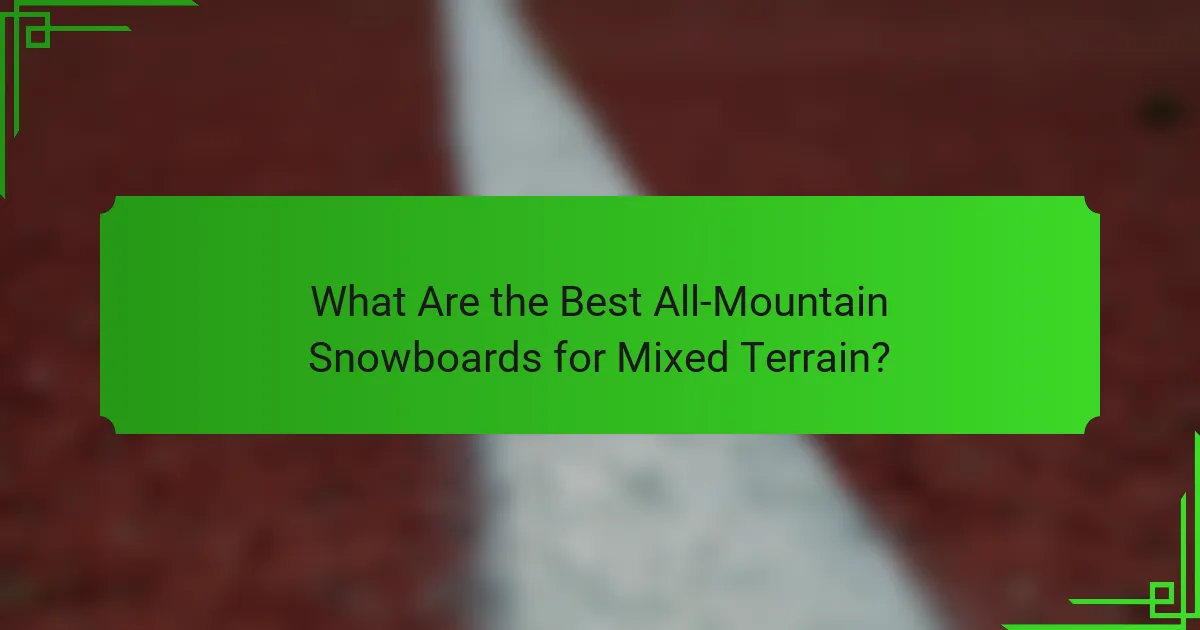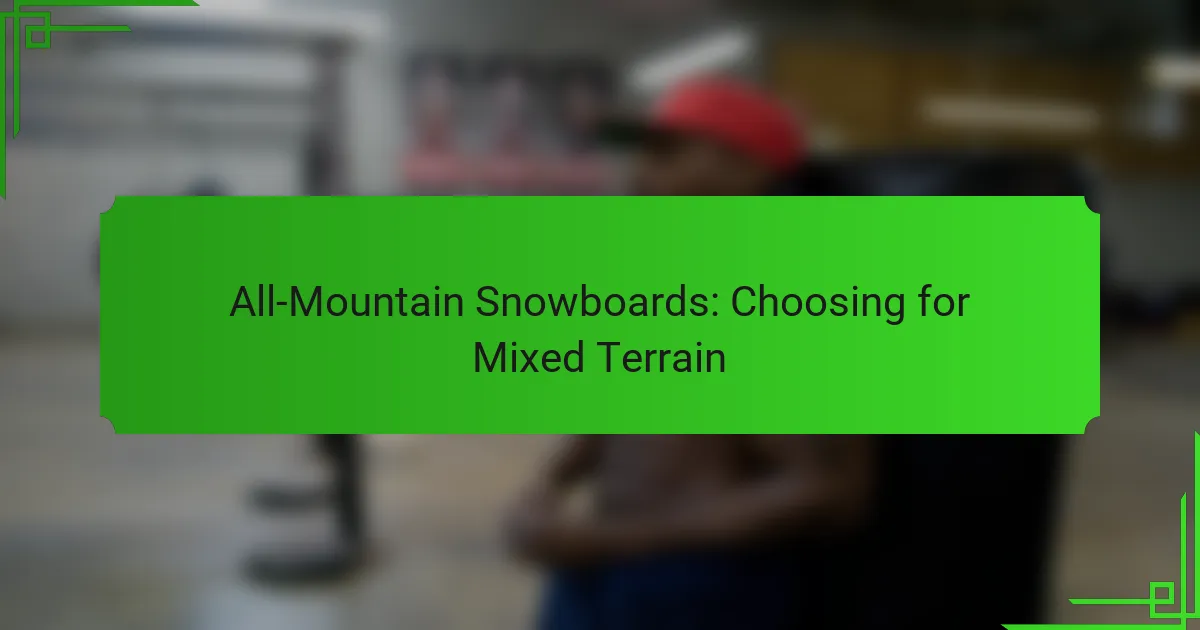All-mountain snowboards are engineered for versatility, enabling riders to confidently navigate a range of terrains, from groomed trails to powder and park features. When selecting the ideal board, it’s essential to consider factors such as your skill level, the board’s flex and shape, and its overall adaptability to different conditions, ensuring an enjoyable experience on the slopes.

What Are the Best All-Mountain Snowboards for Mixed Terrain?
The best all-mountain snowboards for mixed terrain offer versatility, allowing riders to tackle various conditions, from groomed trails to powder and park features. Key factors to consider include flex, shape, and construction, which impact performance across different environments.
Burton Custom Flying V
The Burton Custom Flying V is a hybrid snowboard that combines camber and rocker for a balanced ride. This design enhances float in powder while maintaining stability on hardpack, making it ideal for mixed terrain.
With a medium flex, the Custom Flying V provides a responsive feel without sacrificing comfort. Riders can expect great edge hold and maneuverability, which is crucial when transitioning between different snow conditions.
Lib Tech T.Rice Pro
The Lib Tech T.Rice Pro is designed for advanced riders seeking performance in diverse conditions. Its C2X profile features a blend of rocker and camber, offering excellent float in powder and precision on groomed runs.
This board is known for its durability and eco-friendly construction, appealing to environmentally conscious riders. The T.Rice Pro excels in both park and backcountry settings, making it a versatile choice for all-mountain enthusiasts.
Salomon Assassin
The Salomon Assassin is a versatile all-mountain snowboard that caters to a wide range of skill levels. Its directional twin shape allows for easy switch riding while providing stability and control in various conditions.
Featuring a medium flex and a mix of camber and rocker, the Assassin performs well in powder and on hardpack. Riders appreciate its playful nature, making it suitable for both freestyle and freeride experiences.
Ride Warpig
The Ride Warpig is a unique all-mountain snowboard that stands out for its short, wide design, which enhances maneuverability and float. This board is perfect for riders who want to explore different terrains without compromising performance.
Its hybrid rocker profile allows for easy turns and a playful ride, making it great for both powder and park sessions. The Warpig is particularly well-suited for intermediate to advanced riders looking for a fun, versatile option.
Jones Mountain Twin
The Jones Mountain Twin is a highly regarded all-mountain snowboard known for its versatility and performance. Its directional twin shape and rocker-camber-rocker profile make it adept at handling various terrains, from groomed runs to backcountry powder.
With a medium flex, the Mountain Twin strikes a balance between stability and playfulness, appealing to a wide range of riders. Its eco-conscious construction and durability further enhance its appeal for those looking to invest in a long-lasting board.

How to Choose the Right All-Mountain Snowboard?
Choosing the right all-mountain snowboard involves considering your skill level, the board’s flex and shape, and its versatility across different terrains. These factors will help you find a board that enhances your performance and enjoyment on the slopes.
Consider your skill level
Your skill level is crucial in selecting an all-mountain snowboard. Beginners should look for softer flex boards that offer more forgiveness and easier maneuverability, while intermediate and advanced riders may prefer stiffer boards for better control at higher speeds.
As a general guideline, if you are just starting, opt for boards in the 4-6 flex range. More experienced riders might choose boards with a flex rating of 7-10 for enhanced responsiveness and stability.
Evaluate board flex and shape
The flex and shape of a snowboard significantly impact its performance. A softer flex allows for easier turns and a more playful ride, making it ideal for park and freestyle riding. Conversely, a stiffer flex provides better edge control and stability, which is beneficial for carving and high-speed runs.
Board shape also plays a role; directional boards are designed for riding primarily in one direction, while twin-tip boards allow for riding switch. Consider your preferred riding style when evaluating these characteristics.
Assess terrain versatility
All-mountain snowboards are designed to handle a variety of terrains, from groomed runs to powder and park features. When assessing versatility, look for boards that perform well in different conditions, such as those with a hybrid profile that combines camber and rocker.
Consider how often you plan to ride in different environments. If you frequently switch between groomed trails and backcountry, a versatile board with a balanced flex and shape will enhance your overall experience. Aim for boards that are marketed as all-mountain or versatile to ensure they meet your needs across various terrains.

What Are the Key Features of All-Mountain Snowboards?
All-mountain snowboards are designed to perform well across various terrains, including groomed runs, powder, and park features. Key features include shape, camber profiles, and material construction, all of which influence performance and versatility.
Directional vs. twin shapes
Directional shapes are designed for riding primarily in one direction, offering better stability and control, especially in powder. Twin shapes, on the other hand, are symmetrical, allowing for equal performance in both directions, making them ideal for freestyle riding.
When choosing between these shapes, consider your riding style. If you prefer carving and exploring off-piste, a directional board may be more suitable. For those who enjoy tricks and park features, a twin shape is often the better choice.
Camber profiles
Camber profiles significantly affect how a snowboard interacts with the snow. Traditional camber offers excellent edge control and pop, making it ideal for aggressive riding. Rocker profiles provide better float in powder and easier turn initiation, while hybrid profiles combine elements of both for versatility.
For all-mountain use, a hybrid camber can be a great compromise, offering the benefits of both traditional and rocker designs. Consider your typical conditions and riding preferences when selecting a camber profile.
Material construction
The materials used in snowboard construction impact durability, weight, and performance. Common materials include wood cores for flexibility and responsiveness, fiberglass for strength, and various types of plastics for base and topsheet durability.
When evaluating material construction, look for boards with high-quality wood cores and reinforced edges for longevity. A lightweight board can enhance maneuverability, especially in mixed terrain, but ensure it doesn’t compromise strength.

What Is the Price Range for All-Mountain Snowboards?
The price range for all-mountain snowboards typically spans from around $300 to over $1,500. Factors influencing the cost include brand reputation, materials used, and the technology integrated into the board.
Entry-level options under $400
Entry-level all-mountain snowboards are designed for beginners and casual riders. These boards usually cost between $300 and $400 and offer a good balance of performance and durability.
When selecting an entry-level board, look for features like a soft flex for easier maneuverability and a directional shape that aids in stability. Brands like Burton and K2 often have solid options in this price range.
Mid-range options $400-$800
Mid-range all-mountain snowboards, priced from $400 to $800, cater to intermediate riders seeking enhanced performance. These boards typically incorporate better materials and advanced technology for improved responsiveness and control.
Consider boards with a stiffer flex for better edge hold and stability at higher speeds. Popular models from brands like Ride and Salomon often fall into this category, providing a good mix of versatility and performance.
High-end options above $800
High-end all-mountain snowboards start at $800 and can exceed $1,500, targeting advanced riders who demand top-tier performance. These boards feature premium materials, cutting-edge technology, and superior craftsmanship.
Look for boards with advanced features such as carbon fiber reinforcements and custom flex patterns. Brands like Jones and Lib Tech are known for their high-end offerings, which excel in various conditions and terrains.

Where to Buy All-Mountain Snowboards in the US?
You can purchase all-mountain snowboards in the US at various retailers, both online and in-store. Popular options include specialized snowboard shops, major sporting goods stores, and e-commerce platforms that offer a wide selection and competitive pricing.
Online Retailers
Online retailers provide convenience and often a broader selection of all-mountain snowboards. Websites like Amazon, REI, and Backcountry allow you to compare prices, read customer reviews, and check availability. Look for seasonal sales or discounts, especially during the fall and winter months.
When shopping online, ensure you check the return policy and shipping costs. Some retailers offer free returns, which can be beneficial if the snowboard doesn’t meet your expectations.
Local Snowboard Shops
Local snowboard shops are excellent for personalized service and expert advice. Staff members are often experienced riders who can help you find the right board based on your skill level and preferred terrain. Additionally, buying locally supports small businesses in your community.
Visiting a shop allows you to physically inspect the board and potentially test it out. Many shops also offer seasonal rentals, which can be a cost-effective way to try different boards before making a purchase.
Sporting Goods Stores
Major sporting goods stores like Dick’s Sporting Goods or Academy Sports + Outdoors carry a range of all-mountain snowboards suitable for various skill levels. These stores often have sales during the holiday season and end-of-season clearance events.
While the selection may not be as extensive as specialized shops, these retailers often provide competitive pricing and the convenience of one-stop shopping for gear and apparel.
Second-Hand Options
Buying second-hand can be a budget-friendly way to acquire an all-mountain snowboard. Check platforms like Craigslist, Facebook Marketplace, or local classifieds for used boards. Ensure you inspect the board for any damage or excessive wear before purchasing.
Consider visiting local ski swaps or flea markets, where you can find good deals and sometimes negotiate prices. Just be cautious about the board’s condition and ensure it meets your riding needs.
